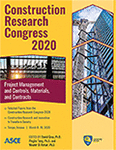Construction Research Congress 2020
Supporting a Model for Increased Labor Time Utilization When Engaging Building Information Modeling for Prefabrication
Publication: Construction Research Congress 2020: Project Management and Controls, Materials, and Contracts
ABSTRACT
Utilizing a building information modeling (BIM) based workflow process, this paper, embedded in a case study environment, defines a workflow model to increase modeling labor time utilization for project teams engaged in prefabrication and installation validation of building components. Through participant observation and structured research methods, the findings highlight the importance of various scheduling techniques, model, and data management procedures, communication protocols, and reality capture processes. This research provides a process framework in which workflows can be streamlined and modeling team labor time utilization rates increased. The increased utilization rates positively impact downstream installation of prefabricated components based upon the coordinated construction model. Additionally, this paper identifies and defines the importance of varying typologies of geometric information within a building information model used for prefabrication in a constrained construction environment. In conclusion, this paper defines an ideal-state project workflow for successfully engaging in BIM-based prefabrication and installation validation in ever changing construction field conditions.
Get full access to this article
View all available purchase options and get full access to this chapter.
REFERENCES
Aziz, R. F., & Hafez, S. M. (2013). “Applying lean thinking in construction and performance improvement.” Alexandria Engineering Journal,52(4), 679–695. https://doi.org/10.1016/j.aej.2013.04.008
CII. (2002a). “Prefabrication, preassembly, modularization, and offsite fabrication in industrial construction: a framework for decision-making.” Construction Industry Institute - Research Summary 171-1.
CII. (2002b). “Preliminary research on prefabrication, preassembly, modularization, and off-site fabrication in construction.” A Report of Center for Construction Industry Studies, The University of Texas at Austin, Research R(July), 160.
Cribbs, John. (2016). “Workflow management using building information modeling (BIM) for prefabrication in a construction retrofit environment.” Arizona State University. https://repository.asu.edu/items/38424 (2016).
Dozzi, S. P., & AbouRizk, S. M. (1993). “Productivity in construction.” Retrieved from http://web.mit.edu/parmstr/Public/NRCan/nrcc37001.pdf (Jul. 31, 2019).
Ghosh, A. (2015). “Analyzing the impact of building information modeling (BIM) on labor productivity in retrofit construction: case study at a semiconductor manufacturing facility.” Arizona State University. https://repository.asu.edu/items/29664.
Harris, A. D., McGregor, J. C., Perencevich, E. N., Furuno, J. P., Zhu, J., Peterson, D. E., & Finkelstein, J. (2006). “The use and interpretation of quasi-experimental studies in medical informatics.” Journal of the American Medical Informatics Association : JAMIA, 13(1), 16–23.
Liker, J.K. (2004). The Toyota Way - 14 Management Principles from the World's Greatest Manufacturer. Madison, WI: CWL Publishing Enterprises, Inc.
McGraw Hill Construction. (2011). “Prefabrication and modularization: increasing productivity in the construction industry.” SmartMarket Report.
NBS. (2019). “National BIM report 2019.” RIBA Enterprises Ltd, 3-54.
NBIMS-US. (2015). “National BIM standard-United States.” National Institute of Building Sciences buildingSMART Alliance.
Rahman, H. A., Wang, C., & Lim, I. Y. W. (2012). “Waste processing framework for non-value-adding activities using lean construction.” Journal of Frontiers in Construction Engineering, 1, 8–13. Retrieved from http://www.academicpub.org/fce/paperInfo.aspx?ID=3.
Sacks, R., & Koskela, L. (2010). “Interaction of lean and building information modeling in construction.” Journal of Construction Engineering and Management, 136(9), 968–981. https://doi.org/10.1061/(ASCE)CO.1943-7862.0000203>.
Sanvido, V. E., & Riggs, L. S. (1993). “Managing successful retrofit projects.” Cost Engineering, 35(12), 25–32.
Teicholz, P. (2004). “Labor productivity declines in the construction industry: causes and remedies.” Retrieved from https://scholar.google.com/scholar?hl=enq=teicholz+productivitybtnG=as_sdt=1%2C29as_sdtp=#0 (Mar. 10, 2015).
Teicholz, P. (2013). “Labor-Productivity declines in the construction industry (another look).” Retrieved from http://www.aecbytes.com/viewpoint/2013/issue_67.html (Feb. 12, 2014).
Zainal, Z. (2007). “Case study as a research method.” Jurnal Kemanusiann, 9, 1-6.
Information & Authors
Information
Published In
Construction Research Congress 2020: Project Management and Controls, Materials, and Contracts
Pages: 841 - 850
Editors: David Grau, Ph.D., Arizona State University, Pingbo Tang, Ph.D., Arizona State University, and Mounir El Asmar, Ph.D., Arizona State University
ISBN (Online): 978-0-7844-8288-9
Copyright
© 2020 American Society of Civil Engineers.
History
Published online: Nov 9, 2020
Published in print: Nov 9, 2020
Authors
Metrics & Citations
Metrics
Citations
Download citation
If you have the appropriate software installed, you can download article citation data to the citation manager of your choice. Simply select your manager software from the list below and click Download.
